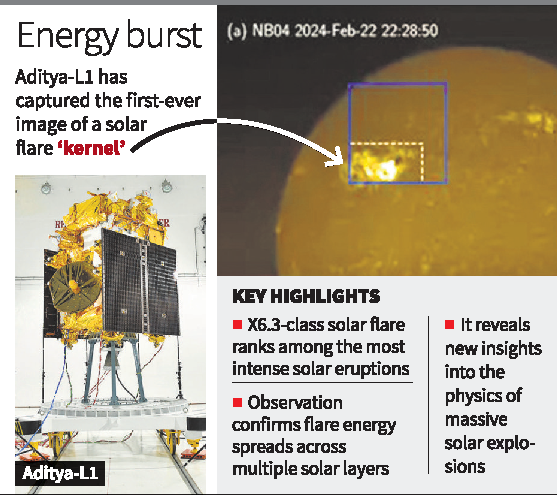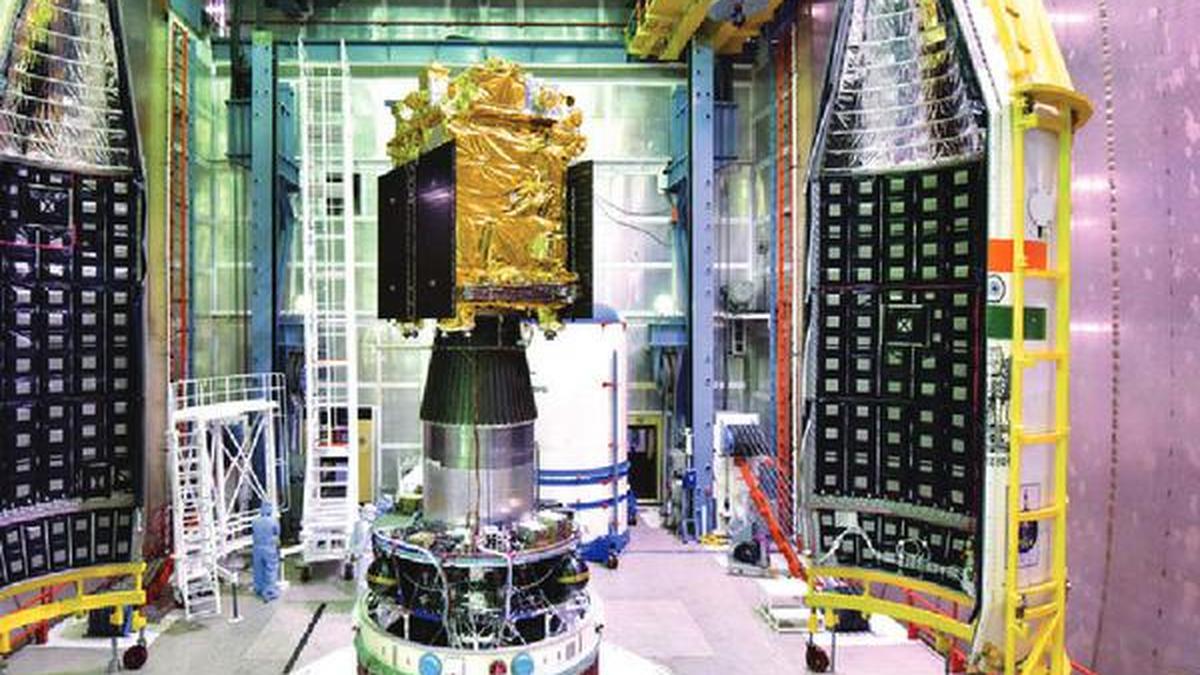Aditya-L1 Mission

- 02 Mar 2025
In News:
ISRO’s Aditya-L1 mission has made a significant breakthrough by capturing the first-ever image of a solar flare 'kernel' using the Solar Ultraviolet Imaging Telescope (SUIT) payload.
Key Highlights:
- Captured Phenomenon:
- An X6.3-class solar flare (among the most intense categories) was observed on February 22, 2024.
- SUIT detected localized brightening in the Near Ultraviolet (NUV) wavelength (200–400 nm), a range never before observed in such detail.
- Scientific Significance:
- Observation occurred in the lower solar atmosphere (photosphere and chromosphere).
- Confirmed energy transmission from the flare through multiple solar atmospheric layers.
- Demonstrated a direct link between flare energy deposition and plasma temperature increase in the solar corona.
- Validated longstanding theories while offering new insights into solar flare physics.
About Aditya-L1 Mission:
- Launch Date: September 2, 2023
- Orbit: Placed in a halo orbit around the first Earth-Sun Lagrange Point (L1) on January 6, 2024.
- Objective: Study solar activities and their impact on space weather.
- Significance: India’s first space-based solar observatory, and ISRO’s second astronomy mission after AstroSat (2015).
Solar Flares – Quick Facts:
- Solar flares are massive explosions on the Sun's surface that release energy, light, and high-speed charged particles.
- Often associated with Coronal Mass Ejections (CMEs) that can affect Earth's magnetosphere and satellites.
- Classification: A, B, C, M, and X — with X-class being the most powerful, increasing tenfold in energy per class.
First Science Result from India's Aditya-L1 Mission

- 04 Nov 2024
In News:
- The Aditya-L1 mission, launched by the Indian Space Research Organisation (ISRO) on September 2, 2023, is India's first dedicated scientific mission to study the Sun.
- Primary Payload: The Visible Emission Line Coronagraph (VELC), developed by the Indian Institute of Astrophysics (IIAp), Bengaluru, is the spacecraft's main instrument.
Key Highlights:
- First Science Outcome:The first scientific result from the mission, involving VELC, has been released. It successfully estimated the onset time of a coronal mass ejection (CME) that occurred on July 16, 2023.
- CMEs are massive solar eruptions that can disrupt electronics in satellites and communications on Earth.
- Key Findings:
- VELC's Role: The VELC payload was crucial in observing the CME close to the solar surface, providing a detailed understanding of its onset.
- CMEs are typically observed in visible light after they have traveled far from the Sun. However, VELC’s unique spectroscopic observations allowed scientists to study the CME much closer to the Sun's surface.
- Publication:The results will be published in the Astrophysical Journal Letters.
- Future Significance:
- As the Sun approaches the maximum phase of its current solar cycle (No. 25), CMEs are expected to become more frequent. Continuous monitoring with VELC will provide valuable data for understanding these events.
- Monitoring the thermodynamic properties of CMEs near the Sun is essential to understand their source regions and behavior.
- Mission Details:
- The spacecraft is in a halo orbit around the Lagrange Point 1 (L1), about 1.5 million kilometers from Earth.
- Mission Lifetime: 5 years.
